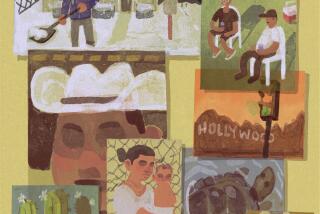Cruising for Deals With a Professional Tightwad
- Share via
It could have been a take from “Candid Camera.” The Times had descended, unannounced, on Laurie Schneider’s garage sale--with the editor of The Tightwad Gazette.
You’re joking, a momentarily ruffled Schneider told her husband, Sascha, when he broke the news. He wasn’t.
We’d hit the Saturday morning sale with Amy Dacyczyn, Maine’s most celebrated miser, who’d come West to tout her new book, “The Tightwad Gazette II.”
As real penny pinchers know, Dacyczyn (pronounced decision), 39, is founder/editor of The Tightwad Gazette, the newsletter, that since 1990 has been preaching parsimony to a nationwide following of the frugal, currently 43,000, not including cheapies who read other people’s copies.
Now here she is, perusing the treasures set out by the Schneiders and their neighbor, Pam Boroski, on the Schneiders’ West L.A. lawn.
Dacyczyn zeros in on a Minnie Mouse T-shirt. “A good thing to buy if you’re going to Disneyland,” she says. That’s a Gazette tip: Pre-buy pre-owned kiddie souvenirs for pocket change, then dole them out when the “I wannas” strike.
From a jumble of toys Dacyczyn plucks a small, slightly chipped, carved and painted cat. “Hit this thing with a little black marker and a little spit and you have a nice piece of folk art.” A dime; she’ll take it.
“You have to be quick and move on,” she says. We move on to Beverly Hills, to an eclectic mix of antiques and junque behind iron gates. A pair of Empire chairs are handsome, but at $200, Dacyczyn says, a bargain only for a do-it-yourself caner.
She inspects an ornate jardiniere stand that’s minus one leg. Not worth $5, she decides, but she’d trash-pick it from a curb in a flash, if only for firewood.
As we move along, she offers a few bargain-hunting strategies:
LP records are “a really good deal, if you can sort of delay your entry into the CD world for a few years.”
In clothes, small sizes are easiest to find. “People get rid of their clothes when they gain weight.
“I give my kids secondhand toys for Christmas.” One caveat: “You will never find a complete erector set at a yard sale.”
Dacyczyn is wearing jeans (firsthand) and a paisley vest (secondhand). For TV guest shots, she’s brought her Gloria Vanderbilt suit ($1.50 at a church thrift shop).
We head for the Roosevelt Hotel in Hollywood to join Symmon and Susan Reese, who’ve come up from Irvine to meet the grande dame of thrift.
The Reeses, young Gazette subscribers, are edging toward tightwaddery. “We really want to buy a home so we’re getting more aggressive,” says Susan, inspired by the oft-repeated saga of Amy and Jim Dacyczyn.
That saga: The Dacyczyns had only $1,500 when they wed in 1982. On his $30,000 a year, they saved $49,000 in seven years while paying $38,000 for two new cars, furniture and major appliances.
They also bought a $125,000 country home, now mortgage-free, and own two other houses, one of which houses the Tightwad Gazette and its staff of eight.
But--let’s get real--that’s in Leeds, Maine (pop. 1,800). Well, Dacyczyn concedes, “Los Angeles is a unique part of the planet.” But, she insists, in most of America a truly thrifty family of six can manage nicely on $25,000 a year by practicing creative deprivation.
That means canning, baking bread, saving string, washing diapers . . . .
“How depressing,” some say. Look, she says, if you love your job, great. If you love it and also make big money, better yet. But “most people don’t have jobs they love” and are “working five hours to pay for an hour’s worth of convenience”--for frozen pizzas, store-bought gift-wrap and the like.
But are you ready for a hammock made from plastic six-pack rings? A jump rope of bread bags? Milk swished in a nearly empty jam jar, frozen in a mold and called a Popsicle? (All tips from the new book).
How about pseudo papier-mache made from dryer lint? A great example of “underground tightwad humor,” Dacyczyn says--and it works!
Lest you label her wacko, she doesn’t hoard lint. Or split two-ply toilet paper into one-ply, as one tightwad suggested. As for that hammock, a reader tip, it’s “on the edge” of over-the-edge.
She rejects ideas that are too time-consuming, save too little money and provide no pleasure, weeds out the illegal, unethical or unsafe--and the tongue-in-cheek. Among the latter: “McScamper,” one family’s strategy for saving eat-out bucks by rushing to grab Big Mac remnants off tables.
Tightwads do spend money, says Dacyczyn--it’s not contradictory, “like being a minister and sleeping with your secretary.” But, she says, they buy only what they need and only if it’s a good value.
While others worship at the shrine of shop-till-you-drop, she explains, tightwads get their emotional rush from not spending. The Dacyczyns haven’t bought a restaurant meal in 10 years. Movies? Only on TV (no cable).
And she swears her kids, ages 3 to 11, happily wear secondhand clothes and bring homemade gifts such as goo, a Silly Putty-Gak hybrid, to birthday parties.
Jim, now retired from the Navy, runs the household and, while their Tightwad Gazette empire generates a six-figure income, the Dacyczyns still live happily beneath their means.
Amy calls it “one-downmanship.”
The Richness of Cultural Diversity
As the legal debate raged over Proposition 187, area high school students wrote of “Immigrants’ Contributions to California” in an essay contest that drew 650 entries. Two entrants walked off with $250 each.
The writers--many of whom expressed their anger over immigrant-bashing and scapegoating--included illegal immigrants and those whose forebears came from Europe in an earlier immigrant wave.
The richness of cultural diversity was a recurring theme. “The Mexican or Asian people’s next Diego Rivera or Frida Kahlo may very likely be living somewhere in California,” one wrote. Another mentioned tacos and egg rolls. Asked another, “Would you like to look at a painting with only one color?”
A young man wrote movingly of his father’s “American dream.” Born in the slums of Monterrey, Mexico, he came with his family to California in 1953 and picked grapes after school for 15 cents an hour. Today he’s a Postal Service superintendent; his oldest child is in college.
A Santa Monica High girl told of Rosa, a young Salvadoran refugee who was her family’s housekeeper. One thing she taught the writer: “The worst thing in life was not the failure to get every toy on your Christmas list.”
First prize for an entry in English went to Jonathan Maack of North Hollywood High. He wrote, “The immigrant mind is the unseen mover behind countless traditions, the immigrant spirit the unseen mover behind countless enterprises, the immigrant hand the unseen mover behind countless industries.”
The winner in Spanish was Jose Alberto Jarquin of Belmont High, an immigrant from Oaxaca, Mexico. He wrote of an immigrant talent pool from which will come leaders to carry on for Cesar Chavez and Martin Luther King Jr.
Without the infusion of beauty and warmth from immigrant cultures, he wrote, California “would be a state of empty avenues.”
USC’s office of civic and community relations sponsored the contest in cooperation with four other community agencies and La Opinion.
More to Read
Sign up for our Book Club newsletter
Get the latest news, events and more from the Los Angeles Times Book Club, and help us get L.A. reading and talking.
You may occasionally receive promotional content from the Los Angeles Times.










